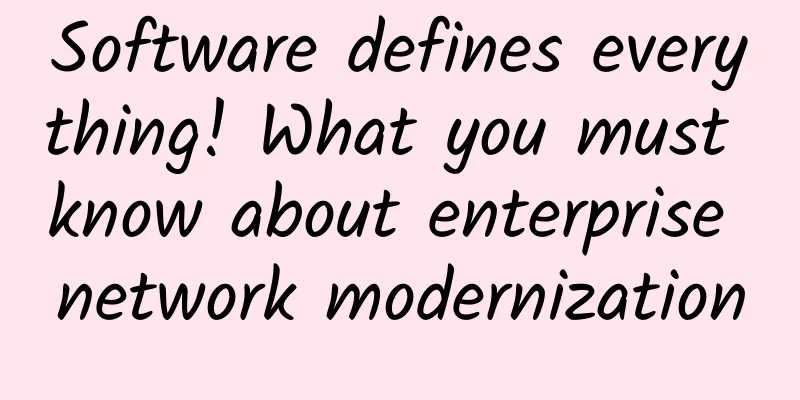Software defines everything! What you must know about enterprise network modernization

|
This article is reprinted from the WeChat public account "Computer World", written by Zeus Kerravala. Please contact the Computer World public account for reprinting this article. The business value of the network has never been higher, driven by digital transformation. This is evidenced by the fact that enterprises have brought forward the introduction of digital projects by seven years due to the COVID-19 pandemic. This has had a profound impact on enterprise networks, as most enabling technologies such as cloud, mobile and IoT are network-centric. The intense focus on digital transformation has exposed many flaws in traditional networks. Traditional networks are rigid, require a lot of manual processes, and lack the flexibility and intelligence to meet the needs of digital business. If enterprises want to maximize their investments in other technologies, they need to make network modernization a priority. Here are five steps all enterprises should consider when modernizing their networks. Software Defined EverythingWith traditional infrastructure, the data plane and management plane are tightly coupled together, so when changes are made across the network, every device must be reconfigured. This can result in months of lead time when changes are made, which is too long for a digital enterprise. Software-defined systems separate the control plane from the data plane, allowing the control plane to be centralized. This allows engineers to make changes from a centralized location and propagate across the network in near real-time. The move to software-based systems is fundamental to network modernization. It’s worth noting that the initial definition of SDN (Software Defined Networking) was related to the data center, while SD-WAN (Software Defined Wide Area Network) was later used as part of WAN modernization. The underlying technology shift is the same for SDN and SD-WAN, but the implementation is very different, which is why they are available from different vendors in the market. For most companies, the teams that run the data center and the teams that run the WAN are separate; other than ease of procurement, there is no incentive to purchase both data center SDN and SD-WAN from the same vendor. Starting with SD-WAN is a smart move because the ROI is typically much greater, and the architecture used to build the existing WAN may be two or three decades old and in need of an update. Data center SDN should be done as part of a larger data center modernization project, such as moving to a private cloud. Embrace AIOpsToday's networks are much more complex than they were in years past. At the same time, they are also more important from a business perspective, as network outages or poor performance can cost a business a lot of money. To help network engineers better manage their networks, most vendors provide real-time telemetry data. The problem is that the volume of data can be so large that even the best engineers can't interpret it quickly and accurately. On the other hand, AIOps (artificial intelligence operations) systems are constantly monitoring and can alert network operations teams to even the slightest anomalies that could cause performance issues. Once trust is built in the system, changes can be automated, but don’t expect perfection right away, as AI systems need to learn. The threshold for justifying AI is that it can do a task better than a human. Considering that human error is the biggest cause of downtime, this is a threshold that can be crossed. Start by adopting AI in the most challenging parts of the network: Wi-Fi and SD-WAN, and then consider expanding. Harness the power of the cloudThe cloud has changed every part of IT except the network: compute, storage, application development, and even security leverage the cloud to provide better scale and agility. Now it’s time for the network to catch up, and decouple the software from the underlying hardware to enable the network to be centralized. In the early days of the software-defined cycle, software was centralized in on-premises controllers, but most vendors also offer cloud options, which bring many benefits. First, all data from the entire network can be centralized, providing a more complete end-to-end network view. On-premises controllers typically restrict the collected data to a single location due to the large storage requirements across the network. In addition, the cloud is used to support the processing of large-scale compute-intensive workloads such as artificial intelligence. A unique feature of cloud management systems is that vendors can compare one organization's metadata with that of other organizations, allowing network engineers to understand how their environment compares to that of other organizations. Because only metadata is used, no sensitive or proprietary data should be used in the comparative analysis. Author: Zeus Kerravala is founder and principal analyst at ZK Research. Original URL: https://www.networkworld.com/article/3628908/5-steps-for-modernizing-enterprise-networks.html |
<<: There are about 180 million users of 5G packages using 4G terminals
>>: Catch it all - Webpack project packaging 1
Recommend
How will the next generation of Wi-Fi change the smart home?
Strategy Analytics predicts that the number of Wi...
I dare say 99.9% of network engineers don’t know the four major indicators for locating wireless network failures!
1. Related concepts 1. Noise Floor Definition: It...
A Brief Discussion on WebSocket Protocol-RFC 6455
Labs Guide Before the emergence of WebSocket, the...
ICO was wiped out, is blockchain technology a blessing or a curse?
In the first half of this year, with the skyrocke...
Weibu Online OneDNS helps the real estate industry with network security
If you are the only security manager of a real es...
High growth in network equipment in Q3 drove an 8.1% increase in cloud IT revenue
Currently, the pace of cloud data center construc...
We cannot allow "free-network tools" to threaten network information security
Recently, the official website of the Ministry of...
Can SD-WAN trigger a comprehensive telecom NFV transformation?
The premise behind a software-centric, virtualize...
The "5G messages" of the three major operators are about to be commercialized. What impact will it have on SMS and WeChat?
At the 5G Message High-level Forum of the China I...
Mobile Edge Computing: The True Future of 5G
The promise of 5G has yet to be fulfilled, but it...
How 5G can drive a sustainable future
IBM Vice President Marisa Viveros said that whil...
Hosteons data center migration, 30% off for annual payment, starting from $11/year for 5 data centers in Los Angeles/New York
Hosteons launched a data center migration plan on...
The Internet of Things in the Eyes of Operators: The Story of the Internet of Things and Two Scissors
Previous article: "The Internet of Things in...
Changing WiFi channels can help you enjoy faster network speeds
In our daily life, when we connect our computers,...
South Korea has nearly 13 million 5G users as of January
Korean media cited data from the Ministry of Scie...









